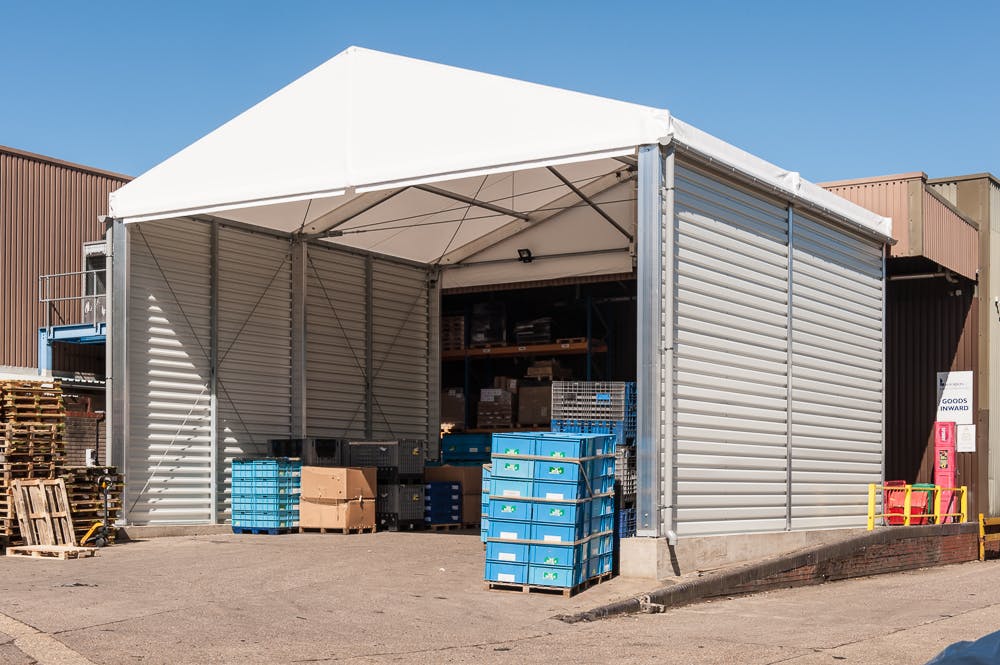What Is an Industrial Marquee?
If you’ve ever heard the term industrial marquee and wondered what one is, you’re not alone. You obviously aren’t going to be partying till dawn in an industrial marquee so what would you use one for and when? And, more importantly, what exactly are they and why do people refer to them as industrial marquees?
What’s in a name?
An industrial marquee is the phrase that some people use to describe an industrial temporary building; something that is demountable, relocatable and typically used for short or long term interim on-site warehousing, storage or operational space. Similar phrases such as industrial tent or storage tent are also sometimes used.
Whether these structures are referred to as a tent, marquee or building doesn’t really matter. What does matter however is whether you are getting a tent, marquee or building and how to make sure you know the difference.
Industrial marquee or building?
An industrial temporary building is similar to a marquee in some ways but the main and major difference is the frame. It will be engineered to a considerably higher specification and be a much thicker and stronger profile; one that can meet the required British Standards for snow and wind loadings and structural safety. Basically, there is no chance of it collapsing in the worst weather the UK can throw at us and your local Building Control won’t need to lose sleep over its existence.
An industrial marquee in its literal form is a marquee that has spent all its life hosting weddings and parties and has now been relegated to warehousing or storage duties. It is a structure that consists of an aluminium marquee frame ( considerably smaller than the frame of an industrial temporary building and not as strong) with soft or hard sided walling added and a PVC roof.
A marquee frame is not strong enough to be used long-term or be classed as a building. At best your local Building Control will ask for it to be taken down if they clock it being in situ for more than 28 days. At worst, the structure won’t withstand the winter weather, particularly high wind speeds and snow loads, and become a serious safety risk for those working in and around it.
Our configurator tool allows you to design your structure to suit your needs. Design your ideal structure and see how it will look in less than 3 minutes! Receive an estimate and copy of your configuration.
Why the confusion?
The confusion could be attributed to 3 key similarities between the two structures. Both use a PVC roof system, both have aluminium frames (although a building uses more aluminium to create a stronger profile as talked about above) and both have a similar installation technique.
The PVC roof used for industrial temporary buildings is certainly an aspect that correlates with some marquees. It is however a strong industrial grade material that is guaranteed for long-term use, affordable, fast and easy to install and simple to replace should it become damaged. It will also allow for a large degree of natural day light, reducing energy bills during day time hours.
Aluminium frames are perfect for structures that need to be moved regularly; marquees, industrial marquees and temporary buildings. Even the larger, stronger profiles of the industrial temporary buildings are lightweight, easy to transport and handle. And, despite being thought of as inferior to steel, an aluminium frame won’t weaken through rust and is malleable meaning it can flex under impact creating additional strength.
Essentially though it’s the lightweight quality that allows the incredible fast, easy and affordable installation technique that both marquees and temporary building can boast. Using different methods to accommodate the variation in frame size and weight, marquees and buildings are fixed down to existing hard ground using stakes, pins or ground anchors, generally negating the need for any costly and lengthy groundworks. This technique also makes them easy to demount and relocate, leaving minimal evidence of their existence.
It’s not hard to see that these similarities could lead to a confusion in whether someone perceives an industrial temporary building as an industrial marquee or not. The problems begin when a supplier knowingly tries to pass off a marquee as an industrial building suitable for long-term use.
How to tell the difference?
It’s all in the frame. A marquee has a small profile, which means a lighter smaller frame that isn’t engineered for long-term use. An industrial temporary building has a thicker, stronger profile engineered and often warranted for ten years and more.
An indicator of a marquee frame being used is the size between each bay/frame leg and the wall height. Often with a marquee the bay distance is around 3m and the wall height can often be a max of just 3m. With a temporary building the bay distance is usually 5m and the wall height can go up to 7m or more sometimes.
To be sure though you need to ask if the building has been engineered to meet the Building Regulation requirements according to BS6399 and equivalent Euro codes. Even better, if they have been engineered to be site specific in accordance with BS6399. If the supplier cannot provide this then yes you may be getting an old marquee that has been relegated to storage duties.
Still concerned about the industrial marquee in your building?
Speak to someone in the building industry, a surveyor or your local building control. Alternatively the technical team at HTS are always available to offer unbiased, factual and helpful advice regarding your industrial marquee or building, even if you’re working with another supplier.
